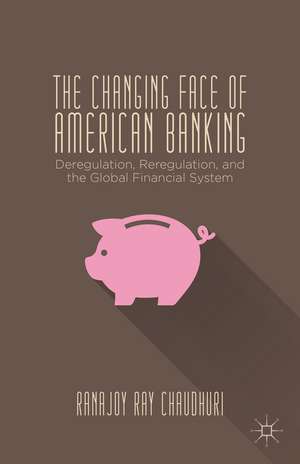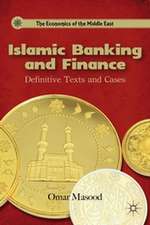The Changing Face of American Banking: Deregulation, Reregulation, and the Global Financial System
Autor Kenneth A. Loparoen Limba Engleză Hardback – 20 aug 2014
Preț: 644.95 lei
Preț vechi: 758.77 lei
-15% Nou
Puncte Express: 967
Preț estimativ în valută:
123.41€ • 129.11$ • 102.52£
123.41€ • 129.11$ • 102.52£
Carte tipărită la comandă
Livrare economică 02-16 aprilie
Preluare comenzi: 021 569.72.76
Specificații
ISBN-13: 9781137365811
ISBN-10: 1137365811
Pagini: 279
Ilustrații: XII, 279 p. 4 illus.
Dimensiuni: 155 x 235 x 23 mm
Greutate: 0.54 kg
Ediția:2014
Editura: Palgrave Macmillan US
Colecția Palgrave Macmillan
Locul publicării:New York, United States
ISBN-10: 1137365811
Pagini: 279
Ilustrații: XII, 279 p. 4 illus.
Dimensiuni: 155 x 235 x 23 mm
Greutate: 0.54 kg
Ediția:2014
Editura: Palgrave Macmillan US
Colecția Palgrave Macmillan
Locul publicării:New York, United States
Cuprins
Table of Contents 1. A Brief Chronology of U.S. Banking Regulations 1.1. The European Origins of Banking 1.2. The Evolution of the American Banking System: A Timeline 2. The Free Banking Era 2.1. The Origins of Free Banking 2.2. The American Free Banking Experience 2.3. Central Banking Activities in the Free Banking Era 2.4. The End of Free Banking 2.5. The Contemporary International Financial System 3. The Big Markets: New York and California 3.1. The Growth of New York 3.2. The Early Days of Banking in New York 3.3. The California Gold Rush 3.4. The Early Days of Banking in California 4. The Little Markets: The Story of Unit Banks 4.1. The Growth of Unit Banks 4.2. The Effect of the Banking Act of 1935 4.3. The Economics of Unit Banking 4.3.1. Bank Size and Bank Profitability 4.3.2. Bank Size and Bank Cost 4.3.3. The Impact of Bank Size on Other Banking Indicators 5. The Early Days of the Federal Reserve 5.1. The Pioneers: Central Banking in Europe 5.2. Central Banking in the pre-Federal Reserve Era 5.3. The Panic of 1907 and the National Banking Commission 5.4. The Federal Reserve Act and the Federal Reserve System 5.5. Structure of the Federal Reserve System 5.5.1. The Federal Reserve Banks 5.5.2. The Board of Governors 5.5.3. The Federal Open Market Committee 5.6. The Evolution of the Federal Reserve System 5.6.1. The Early Years 5.6.2. The Discovery of Open Market Operations 5.6.3. The Great Depression 5.6.4. The Accord of 1951 5.6.5. Monetary Policy Targets 5.6.6. The Evolution of the Federal Reserve's Macro Models 6. The Great Depression & the Glass-Steagall Act 6.1. The International Economy following the First World War 6.2. The Causes of the Great Depression 6.3. The Response of the Federal Reserve 6.4. The Banking Acts of 1933 and 1935 6.5. Fiscal Policy Measures for ending the Depression 7. The Stable Years 7.1. The International Economy following the Second World War 7.2. Banking Policy during the Period 7.2.1. The 3-6-3 Rule 7.2.2. Bank Holding Company Act of 1956 7.2.3. Other Banking Acts of the Time 7.3. Fiscal Measures during the Period 7.3.1. Fair Deal 7.3.2. The Eisenhower Administration 7.3.3. New Frontier 7.3.4. Great Society 7.3.5. The U.S. as the Leading Global Creditor 7.4. The Demise of the Bretton Woods System 8. The Housing Market and the Savings & Loan Associations Crisis: The 1980s 8.1. The European Origins of Savings & Loan Associations 8.2. The History of Savings & Loan Associations in America 8.3. The Causes of the Crisis 8.4. A Timeline of the Savings & Loan Crisis 8.5. Subsequent Developments 9. Deregulation and the Great Recession: The 1990s and the 2000s 9.1. The Economic Policies of the Clinton Administration 9.1.1. A Federal Budget Surplus! 9.1.2. The National Debt 9.1.3. The Deficit Reduction Act 9.1.4. The Taxpayer Relief Act of 1997 9.1.5. The Balanced Budget Act of 1997 9.2. Legislation Regarding the Banking Industry 9.2.1. The Riegle-Neal Interstate Banking and Branching Efficiency Act of 1994 9.2.2. The Gramm-Leach-Bliley Act of 1999 9.2.3. The Commodity Futures Modernization Act of 2000 9.3. Other Deregulatory Measures during the Clinton Years 9.4. The Economy during the George W. Bush Years 9.4.1. The Dot-Com Bubble 9.4.2. The September 11 Attacks 9.4.3. The Tax Cuts of 2001 9.4.4. The Tax Cuts of 2003 9.5. The Financial Sector under the Bush Presidency 9.5.1. The Legacy of the Commodity Futures Modernization Act 9.5.2. The Sarbanes-Oxley Act of 2002 9.5.3. The Fair and Accurate Credit Transactions Act of 2003 9.5.4. The Bankruptcy Abuse Prevention and Consumer Protection Act of 2005 9.6. The Causes of the Financial Crisis of 2007-2008 9.6.1. The Housing Sector 9.6.2. The Availability of Cheap Credit 9.6.3. The Rise in Interest Rates 9.6.4. The Growth of Subprime Lending 9.6.5. Securitization 9.6.6. Faulty Credit Ratings 9.6.7. The Rise in Oil Prices 9.6.8. A Global Contagion 9.7. A Timeline of the Crisis 9.7.1. The Unfolding of the Crisis 9.7.2. The Emergency Economic Stabil
Notă biografică
Ranajoy Ray Chaudhuri is Lecturer int the Economics Department at The Ohio State University, USA.















